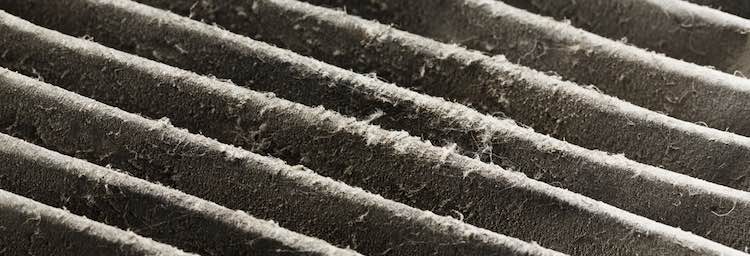There are two groups of people: Those who change their air filters regularly (kudos to you if you’re in this group), and those who don’t.
Those who do change their filters generally have a better air quality, an air conditioner that works well, and lower electric bills. That said, if you fall into this category and find that your filters are black when you change them, you’re probably wondering what’s causing the air inside your home look like you live in a furnace.
In the interest of keeping your lungs healthy, below is a list for possible culprits.
Why are my AC filters turning black?
It’s common for your air conditioner filters to be covered in gray dust when you take them off to clean them or replace them. That’s what regular dust looks like. However, if over and over again you keep finding black residue on your filters, you have a more serious problem.
1. Soot.
If anyone smokes in your home, the soot is coming from cigarette or cigar smoke. If this is the case, we recommend installing HEPA filters. The acronym stands for High Efficiency Particulate Air and they are the most efficient at removing airborne particles found in tobacco smoke.
If no one in your home smokes, the soot could be coming from a gas furnace. Check to see the color of the flame. If it’s blue, everything is working properly. If it’s yellow or orange, your HVAC system is likely obstructed.
If you don’t have a gas furnace, the soot could be caused by scented candles. You know how some of them cost an arm and a leg at candle specialty shops and others are cheaper than dirt at discount stores? This is because some are better quality than others. Those with braided wicks produce less soot. Avoid candles that have petroleum jelly listed as one of its ingredients.
As an extra preventative measure, you could install an activated carbon air purifier, since these work best at removing soot particles form the air in your home.
2. Mold.
Starting with the worst-case scenario (to get it out of the way): mold. Considering that Florida has such high levels of humidity, this isn’t a surprise. That said, you can take preventive steps to reduce the likelihood of developing this issue:
– Conduct a home energy audit. This will pinpoint any leaks along your roof, walls, or air ducts.
– Install a humidistat. This will allow you to control the humidity level inside your home.
– Conduct a mold inspection. This will help you narrow down whether you have a household-wide issue or if the mold is growing solely in your AC filters due to humidity condensation on the coils.
3. Improper ventilation.
Granted, in Florida, it’s not standard to find homes with fireplaces. However, some homeowners have a fireplace, whether for aesthetics or warmth. Our “winters” do sometimes become downright cold (before anyone rolls their eyes at this statement, note that we’ve had temperatures in the 20s).
If this is your situation, ensure you have proper ventilation, or at the very least, an air purifier.
4. Type of air filters.
The price of air filters can vary widely, depending on their materials, MERV rating (Minimum Efficiency Reporting Value), and whether they are washable. Determining which one you need depends on circumstances within your home (whether there are any allergy sufferers, pets, smokers, or the amount of people living with you). Be aware that filters made with fiberglass need to be changed the most often. If you fail to do so, you may encounter black filters when you finally get around to changing them.
Contact Colman Heating & Air for AC Service in Brevard County
At Colman, we understand that sometimes, AC issues happen during the most inconvenient times. This is why we have a 24/7 AC emergency line. Call us if you need assistance ASAP, to schedule routine HVAC maintenance, or for a recommendation on which type of air filters best fit your needs.
24-HR Emergency Service (321) 269-4565







Leave a Reply